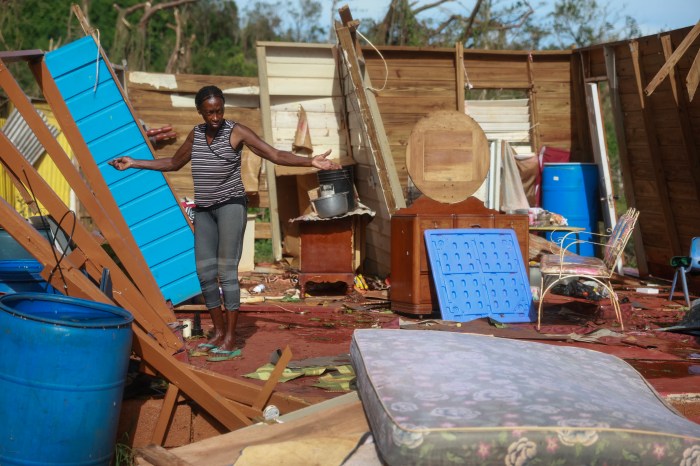Dominica’s embattled government Wednesday threw out a region and worldwide appeal for help after Category Five Hurricane Maria pulverized the Caribbean trade bloc nation that is wedged between the French dependencies of Guadeloupe and Martinique, killing seven people and setting the country back by millions, two years to the month when Hurricane Erica had also battered the island of 72,000.
Video footage posted by the Barbados Nation Newspaper from an overflight by a Regional Security System aircraft showed large holes in state and private buildings, debris scattered as far as the eye could see and the type of desolation normally associated with the aftermath of a major natural disaster.
As Maria took its time over Dominica on Monday night, Prime Minister Roosevelt Skerrit appeared to sum up as situation as succinctly and as pellucid as he could saying in one of his last social media postings that “we have lost all what money can buy. We will need help my friend. We will need all kinds of help,” he said before the power went out island wide.
Dominica’s French neighbors were also reporting widespread damage to property and at least two deaths. Two boaters are also believed to be missing.
With adequate time and warnings to prepare, Caribbean Community governments rushed to send aid and supplies to Dominica even as they were ironically still doing so for a number or countries which were affected by mega storm and equal opportunity destroyer Irma a mere two weeks ago.
The St. Lucia and Antiguan governments asked donors to use their island as staging bases for relief supplies and promised that all paper work and duties would be waived as this is a regional emergency.
For the region, the 2017 storm season is one of the worst on record with so many member nations in a state of disrepair from Irma, Maria and possibly Lee which forecasters are tracking. Up to midweek it was way out in the Atlantic.
In New York for the annual UN General Assembly meetings and reflecting on a miserable storm season, Guyanese President David Granger mused that the time had perhaps come for regional leaders to see how Guyana, with its vast landscape and resources, could be of help to islands battered each year by hurricanes.
“We have to sit down and speak to other CARICOM states to see how this gift (of land) could be utilized to give the Caribbean people a better life in the wake of these disasters. In my lifetime, I have never seen such as catastrophic series of hurricane,” he told reporters. Granger is 73.
As private citizens and private sector groups mobilized relief aid especially to Dominica, Maria was pounding nearby Puerto Rico which had last experienced a similarly categorized storm back in 1928 and was also headed to the US Virgin Islands even as citizens there are also struggling to recover from Irma.
And as Dominican officials assessed the damage and as CDEMA, the umbrella response agency was sending supplies to the island, Principal Prime Ministerial Adviser Hartley Henry joined his boss in appealing for worldwide help, two years after a battering from the last storm.
He said all mobile phone towers were down, electricity out island wide and PM Skerrit was able to communicate with colleagues and the outside world through a satellite phone handed to him by French authorities.
“Maria was a category five hurricane. I am not sure if any of the Caribbean islands can withstand a cat-five. We need tarpaulins, bedding and sleeping material to the country, certain canned foods,” he said. “This has been a serious punch to the heart but not the soul. The rebuilding effort from Erica has been brought back to zero, perhaps minus zero.”
But he said some of the national infrastructure damaged two years ago stood up this time through better construction but Maria appeared to aim her wrath more at buildings rather than roads as was the case the last time. The Melville Hall Airport terminal in the north of the island sustained significant damage but Henry said the tarmac could be in operational in a few days.
























